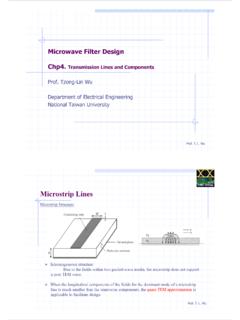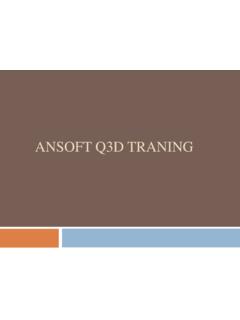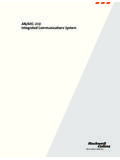Transcription of Receiver Design - ntuemc.tw
1 Prof. Tzong-Lin WuEMC LaboratoryDepartment of Electrical EngineeringNational Taiwan University2011/2/21 Receiver Design1MW & RF Design / Prof. T. -L. Wu2011/2/21 The Receiver mush be very sensitive to -110dBm and working on strong adjacent channel signals. Minimum detectable signal, dynamic range and the need for AGC. Filtering at different stage of Receiver for image and spurious star LEO low earth orbit satellite phone2MW & RF Design / Prof. T. -L. Wu2011/2 Receiver ArchitectureReceiver requirements High gain ~100dB Selectivity Down-conversion Detection of received signal Isolation from the transmitter to avoid saturation of & RF Design / Prof. T. -L. Wu2011/2/21MW & RF Design / Prof. T. -L. Wu4 Because the typical signal power level from the receive antenna may be as low as -100 to -120 dBm, the Receiver may be required to provide gain as high as 100 to 120 dB. This much gain should be spread over the RF, IF, and baseband stages to avoid instabilities and possible oscillation; It is generally good practice to avoid more than about 50-60 dB of gain at any one frequency can be obtained by using a narrow bandpassfilter at the RF stage of the Receiver , but the bandwidth and cutoff requirements for such a filter are usually impractical to realize at RF frequencies.
2 It is more effective to achieve selectivity by downconvertinga relatively wide RF bandwidth around the desired signal, and using a sharpcutoffbandpassfilter at the IF stageto select only the desired frequency communications systems usually use separate frequency bands for transmit and receive, thus avoiding the difficult (but not impossible) problem of isolating incoming and outgoing radiation at the same frequency. In addition, it is often preferred to use a single antenna for both transmit and receive. In this case it is necessary to use a duplexingfilter to provide isolation between the transmitter and Receiver , while still providing a signal path with the antenna2011/2/21 Tuned radio frequency (TRF) receiver5MW & RF Design / Prof. T. -L. WuA TRF Receiver employs several stages of RF amplification along with tunable bandpassfilters to provide high gain and tuning is very difficult because of the need to tune several stages in parallel, and selectivity is poor because the passbandof such filters is fairly broad.
3 In addition, all the gain of the TRF Receiver is achieved at the RF frequency, limiting the amount of gain that can be obtained before oscillation occurs, and increasing the cost and complexity of the receivers are seldom used conversion Receiver (homodyne Receiver ) Two stage amplifiers No need for IF amp and filter No need for extra circuit for AM demodulation No image filter required High stable LO source required. often used with Doppler radars, where the exact LO can be obtained from the transmitter, but a number of newer wireless systems are being designed with direct conversion receivers6MW & RF Design / Prof. T. -L. WuUsing a mixer and local oscillator to perform frequency down-conversion with a zero IF receiver7MW & RF Design / Prof. T. -L. WuA midrange IF allows the use of sharper cutoff filters for improved selectivity, and higher IF gain through the use of an IF amplifier. Tuning is conveniently accomplished by varying the frequency of the local oscillator so that the IF frequency remains majority of broadcast radios and televisions, radar systems, cellular telephone systems, and data communications systems2011/2/21MW & RF Design / Prof.
4 T. -L. Wu8At microwave and millimeter wave frequencies it is often necessary to use two stagesof down conversion to avoid problems due to LO Txand Rx not at the same time, a T/R switch is ok. Diode switch can operate at microseconds, offer 40dB isolation. For Txand Rx at different frequency, bandpassfilters are required for & RF Design / Prof. T. -L. WuIf a single antenna is to be used for both transmit and receive in a duplex system, aduplexermust be used to allow both the transmitter and Receiver to be connected to theantenna, while preventing the transmit signal from directly entering the between the transmitter and Receiver is usually required to be greater than 100 & RF Design / Prof. T. -L. WuFull-duplex systems usually use separate transmit and receive frequency bands withbandpassfilters to provide can also provide some preselectivefiltering on receive, and attenuate spurious out-of-band signals from the transmitter. Duplexingfilters often have insertion losses on the order of 1-3 dB, however, which degrades the noise figure of the related component is a diplexer,a term generally used to refer to a device that combines two or more frequency components into a single a duplexingfilter used with different transmit and receive frequency bands fits this definition, it is sometimes referred to as a & RF Design / Prof.
5 T. -L. Wu2011/2/2112MW & RF Design / Prof. T. -L. Wu2011/2 Dynamic RangeReliable communication requires a receive signal power at or above a certain minimum level, which we call the minimum detectable signal (MDS).Minimum detectable signal (MDS) determines the minimum SNR at the demodulator for a given system noise power. Minimum detectable signal (MDS) 13MW & RF Design / Prof. T. -L. Wu2011/2/21 SINAD: signal-plus-noise-plus-distortion to noise-plus-distortion ratio of (a) total received power, , the received signal-plus-noise-plus-distortion power to (b) the received noise-plus-distortion & RF Design / Prof. T. -L. WuKnowing the minimum SNR or SINAD and the noise characteristics of the receiving system allows us to calculate the minimum detectable signal Detectable Power2011/2/21MW & RF Design / Prof. T. -L. Wu15the output signal powerReceiver Noise temperaturetotal output noise powerwhere B is the bandwidth of the Receiver (usually set by the IF bandpassfilter).
6 2011/2/2116MW & RF Design / Prof. T. -L. WuMinimum detectable input signal levelThis is an important result, relating the minimum detectable signal power at the input of the Receiver to the noise characteristics of the receiving system and the minimum SNR required for that equation provides the interface between the radio link equation ( , the Friisequation or ground reflection link equation) and the SNR or error rate equations of Chapter 9, thereby allowing characterization of the complete wireless & RF Design / Prof. T. -L. Wu17 This equation can be conveniently expressed in dB:2011/2/21MW & RF Design / Prof. T. -L. Wu18 Although ( ) are sometimes used in place of ( ), it is important to realize that ( and ) are only valid when the antenna temperature is 290 K, this situation is seldom true in practice. In either case, note that the minimum detectable signal level does not depend on the gain of the Receiver , since both signal and noise are increased important points:2011/2/2119MW & RF Design / Prof.
7 T. -L. Wu2011/2/2120MW & RF Design / Prof. T. -L. Wu2011/2/21 SensitivityReceiver voltage sensitivity or sensitivity:The minimum detectable signal power can be converted to a minimum detectable signalvoltage, for a given Receiver input rangeReceiver dynamic rangeDepends on noise, modulation scheme, and required minimum maximum allowable signal power could alternatively be defined by the third-order intercept point, P3, at the input to the Receiver , as this would be the maximum input power before intermodulationdistortion becomes & RF Design / Prof. T. -L. Wu2011/2/2122MW & RF Design / Prof. T. -L. Wu2011/2/2123MW & RF Design / Prof. T. -L. Wu2011/2/21MW & RF Design / Prof. T. -L. Wu24 The above examples show the need for about 80-100 dB of Receiver gain to raise theminimum detectable signal to a usable level of approximately 10 mW(about 1 V peak at 50 ohm).Most of the gain occurring at the IF stage becauseAmplifiers and other components are generally cheaper at lower frequencies.
8 High input signal levels may exceed the 1 dB compression point (P1),or the third-order intercept point (P3), of the front-end components if the gain of the early stages is too level of gain at the RF stage sets a good noise figure for the Receiver gain control2011/2/21MW & RF Design / Prof. T. -L. Wu25 Dynamic range at the output of the Receiver is much smaller than the 80-100 dB dynamic range at the Receiver input. (why?)At the output of the Receiver the detected baseband signal often drives a digital signalprocessing (DSP) circuit, or a digital to analog converter PAC), where the input voltagerange is typically 1 mV to 1 V. For example, in a digital PCS telephone Receiver the input signal is demodulated to recover digitized data, and then converted to an analog voice signal with a DAC. A 10-bit DAC with a maximum output voltage of 1 V has a resolution of1/210= 1/1024 ~ 1mV, and provides a dynamic range of 201og 1000 = 60 gain control2011/2/21 Automatic gain control26MW & RF Design / Prof.
9 T. -L. WuThe power gain through the Receiver must therefore vary as a function of the input signal strength in order to fit the input signal range into the baseband processing range, for a wide range of input signal variable-gain function is accomplished with an automatic gain control (AGC) circuit. AGC is most often implemented at the IF stage,2011/2/2127MW & RF Design / Prof. T. -L. WuIt consists of a variable voltage controlled attenuator (or variable gain amplifier) with a detector to convert a sample of the IF voltage to a DC rectified signal is then compared with a reference level, and passed through a low-pass filter to provide a time constant long enough to avoid having the AGC following low-frequency components of the modulated & RF Design / Prof. T. -L. Wu28 Compression and Third-order IntermodulationPower exceed P1 dB will cause harmonic distortionPower exceed IP3 will cause intermodulationdistortionIt is important to track power levels through the stages of the Receiver to ensure that P1 and P3 are not an AGC attenuator in the RF stage may reduce the possibility of saturatingthe RF amplifier with a large input signal, but will degrade the noise performance of thereceiver, even for a low attenuator & RF Design / Prof.
10 T. -L. Wu2011/2 Frequency conversion and filteringIF frequency less than 100 MHz for lower cost of selections are: crystal, ceramic and surface acoustic wave filters30MW & RF Design / Prof. T. -L. WuA key decision in the Design of a superheterodynereceiver is the choice of IF IF frequency is related to the RF and LO frequencies byWhile it is possible to use a local oscillator either above or below the RF signal frequency,most receivers use the lower sideband, so that the LO frequency is given byThe mixer also responds to an RF image frequency separated by twice the IF frequency:Because the image signal is often removed by filtering, using a large IF frequency eases the cutoff requirements of the image filter. In addition, to ensure that the image frequency is outside the RF bandwidth of the Receiver , it is necessary to have2011/2/21 Filtering31MW & RF Design / Prof. T. -L. WuFiltering is required in a superheterodynereceiver to provide interference rejection,image rejection, selectivity, and suppression of LO preselect filterThis is a bandpassfilter set to the RF tuning range of the rejects out-of-band interference, which is particularly important for preventing strong interference signals from saturating the RF amplifier or mixer.









